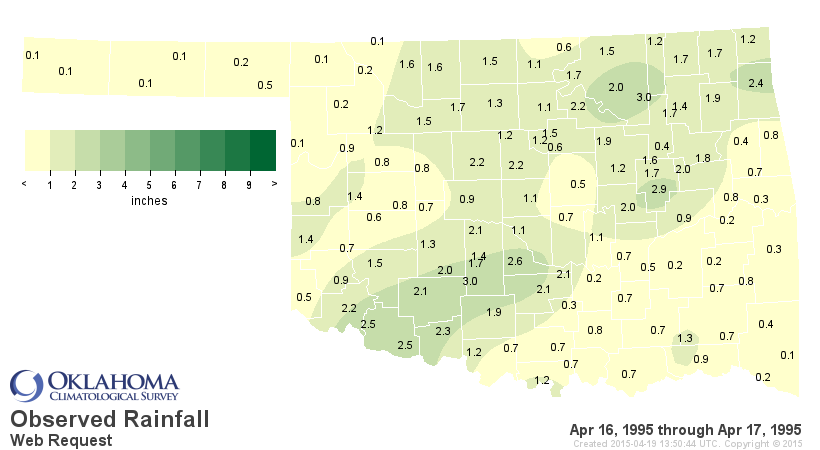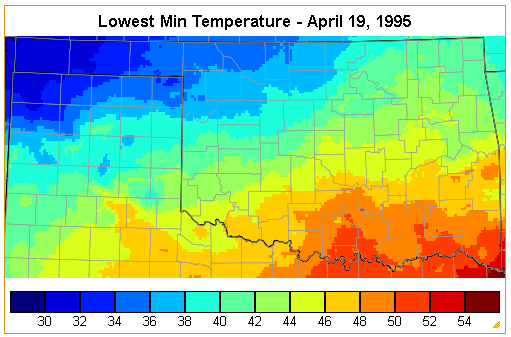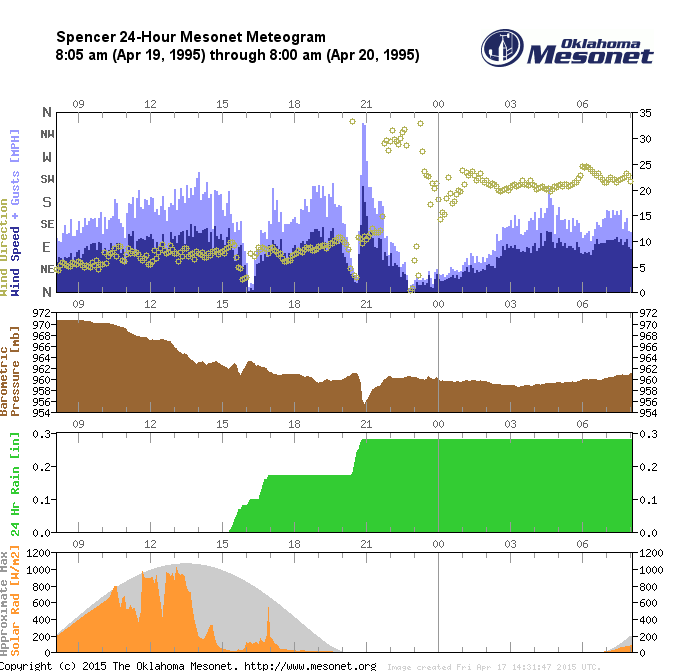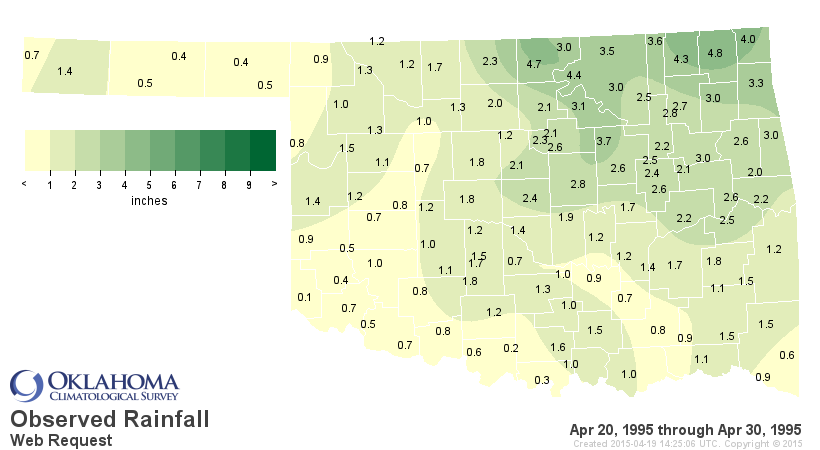Ticker for April 19, 2015
MESONET TICKER ... MESONET TICKER ... MESONET TICKER ... MESONET TICKER ...
April 19, 2015 April 19, 2015 April 19, 2015 April 19, 2015
April 19, 1995
There's little I can add to the story of the Murrah Building bombing 20 years ago
today. Like many Oklahomans, I could merely watch in horror at the terrorist
attack on our home soil and volunteer my time and resources to help our fellow
Oklahomans that were personally impacted in the aftermath. I was a mere grad
student at the University of Oklahoma at the time, more concerned with the weather
of both the previous and next few days than I was anything else. Following 9:02am,
however, those other concerns soon faded into a tapestry of at first horror and
tragedy of those 168 souls lost to the violence that day, as well as the nearly
700 others injured by the blast. But as with the aftermath of weather disasters,
of which Oklahomans are so used to, the weave of that tapestry would eventually
become one of resilience, pride and hope.
What many forget, overshadowed by the bombing itself, is that the state was
still recovering from something of a mini-outbreak of severe weather
a couple of days earlier on the 16th and 17th. Three tornadoes touched down on
the afternoon of the 16th and an additional 16 struck on the 17th. Most were of
the weak variety, F0s and F1s, but there were also three F2 tornadoes that day
near Temple in Cotton County, Okay in Wagoner County and Tahlequah in Cherokee
County. Southwestern Oklahoma seemed to bear the brunt of the damage with
businesses and other structures damaged throughout the area. Oklahoma City
reported an inch of rain with the storms, but escaped most of the severe
weather. The storm system brought some very nice moisture with it those two
days, however, always a precious commodity in the Oklahoma spring.

The 18th offered a nice respite with a high of 66 degrees in Oklahoma City after
another cool start at 45 degrees. The morning of April 19, 1995, started a bit
cool under a crystal clear blue sky. The low that morning was 43 degrees at
Will Rogers Airport, on its way up to a high of 63 degrees. As is the way with
Oklahoma, climatologically speaking, it was a bit warmer to the southeast and
a bit cooler (if not downright cold) to the northwest.


Many things hampered the search and rescue efforts of the bombing throughout the
day. Most famously, of course, would be the worry of further explosions, but
eventually the weather would play its role in that problem as well. A low
pressure system to the west would once again bring the threat of storms and
severe weather to the state as the day wore on. A line of storms formed in
NW Texas and SW Oklahoma that afternoon and marched towards Oklahoma City,
forcing another evacuation of rescue workers as fears for the stability of the
building continued.
A radar loop from the day shows two rounds of weather moved through Oklahoma
City in the aftermath of the bombing, once in the afternoon and another more
hefty line later that evening.

Rain gear was issued to rescuers and volunteers. The second line was thought to
pose a more serious hazard as high winds, hail and lightning were much more
prevalent with that system of storms. Three tornadoes also touched down in
Oklahoma that day, lost forever in time by the shadow of the much larger tragedy
of the Murrah Bombing. All of those twisters were weak, however, and little
damage was reported with them.
The threat of wind and rain was capture by the nearby Spencer Mesonet site,
detailed in this meteogram from 8:05am of the 19th through 8am on the 20th. You
can see winds gusted to 35 mph that evening, quite tame by Oklahoma standards,
but the threat of stronger winds would obviously pose a hazard to rescue workers.

As with most springs in Oklahoma, the threat of weather would continue throughout
the relief efforts over the next several weeks. This was noted in the OK Dept.
of Civil Emergency Management After Action Report:
"The operation was also delayed by mother nature. During the 17-day
mission, rescue workers were subjected to high winds, rain, sleet,
lightning and hail on numerous occasions."
You can see evidence of that in the Mesonet rainfall totals map for the remainder
of the month.

As we pause to reflect on this day, the 20th Anniversary of that horrific act
of terrorism that took so many precious lives, there's little for the Ticker
to add. But the weather marches on and on in Oklahoma, playing its part in our
everyday lives. Sometimes it creates its own tragedy, and at other times it
acts as a sentinel to others. But Oklahomans respond to them all with the
same determination, resiliency and hope, regardless of the cause.
Oklahoma Proud indeed.
Gary McManus
State Climatologist
Oklahoma Mesonet
Oklahoma Climatological Survey
(405) 325-2253
gmcmanus@mesonet.org
April 19 in Mesonet History
| Record | Value | Station | Year |
|---|---|---|---|
| Maximum Temperature | 95°F | HOLL | 2023 |
| Minimum Temperature | 21°F | BOIS | 2013 |
| Maximum Rainfall | 2.67″ | SLAP | 2004 |
Mesonet records begin in 1994.
Search by Date
If you're a bit off, don't worry, because just like horseshoes, “almost” counts on the Ticker website!